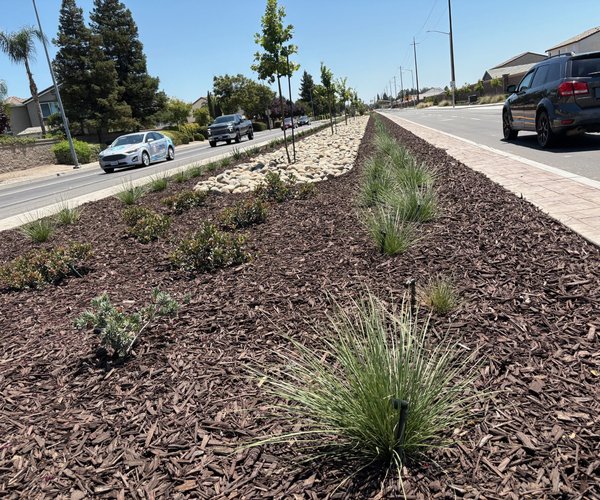Manteca is taking its city hall turnaround to the streets.
A decade plus after Manteca’s streets division manpower was more than halved during Great Recession cutbacks and 46 years after Proposition 13 rewrote the rules for funding city services, the city is now equipping its staff to do more pavement repairs while funding mechanisms are being put in place to cover future tabs for maintaining new residential streets.
At the same time, it’s doubling down on its annual effort to address major road repairs while continuing its yearly effort to extend the life of as many miles of neighborhood pavement they can secure the funds to cover.
Tuesday’s City Council meeting offered examples of three of the efforts.
The council:
*Authorized spending $600,000 for an asphalt grinder and skid steer as part of its effort started last year to have its street crews do more complex road repairs such as was done on Spreckels Avenue just north of Moffat Boulevard.
*Imposed a community facilities district fee for 640 new homes being built to make owners pay annually into a fund to cover the future costs of maintaining streets developers build in the subdivision and then turnover to the city.
*Called for bids for a $3 million project this summer to replace failing pavement in the stretch of Louise Avenue from Main Street to the roundabout just east of the Highway 99 overcrossing.
Airport Way demonstrates
challenges city is facing
The road maintenance and gap issues are an expensive proposition.
The perfect example is Airport Way.
In 2022, it was determined to address all driving surface maintenance issues and to bring the corridor up to adopted expectations with most of it being four lanes between Roth Road and Woodward Avenue it would cost $130 million.
And that didn’t include the $28 million for interchange work as was done at Union Road and Airport Way.
The $130 million price tag is almost twice what the city spends every year on police, fire, basic street upkeep, parks and recreation, as well as general government services.
How the city decided to attack the needs on the Airport Way corridor in more financially chewable bites reflects an important element of the “new” street strategy.
Instead of waiting to accumulate the funding needed to do an entire section of the corridor with 100 percent new pavement or an equipment overlay while addressing more egregious base issues beforehand, the city opted to address only the true need.
It meant different type of repairs would be conducted where it was needed in stretches and no work done on other pavement
Call it a patchwork approach, if you will.
It didn’t end up looking physically “pretty”, but when the $3.8 million project was done in 2022 it provided a less jarring and a safer driving surface.
The project used three levels of fixes depending on how bad the pavement condition.
It included 8,890 linear feet of pavement in immediate danger of failing, 13,195 linear feet of pavement that was within one to three years of failing, and 10,665 linear feet of pavement within three to five years of failing.
As such, the strategy basically stops delaying needed work which avoided further pavement quality condition slippage that significantly increases repair costs
As for lane widening, median work, as well as curbs, gutters and sidewalks it is being done as it has always been done — when property bordering Airport Way is developed.
It has the added bonus of replacing aging sections of roadway adjoining property being developed.
Addressing other major
streets, less egregious
issues & future street work
The Manteca City Council decide to use some of the leftover COVID-19 federal relief pass through funds to buy the initial equipment for city crews to address non-routine street maintenance issues.
In the past that has all been contracted out.
Some of it may still be depending upon the need and the ability of the city to free up street crew staffing that was just recently returned to 2008 levels after being halved.
That said, by doing the work in-house it reduces the cost which means more work can be done. It also can typically be done in a timelier manner.
In defense of previous city decisions, Manteca is now at the point where it is large enough and there is enough work for an in-house approach to be cost effective.
The city has been more focused in chasing down federal and state dollars so address major corridor work in the past five years.
That has led to major redo on Yosemite Avenue from Main Street to Cottage Avenue, Main Street from Yosemite Avenue to the 120 Bypass, and a section Lathrop Road immediately east of Airport Way.
Prior to that, Louise Avenue from Main Street to the railroad tracks was redone.
The next major project is Louise Avenue between Main Street and the bridge across the freeway.
There’s six months or less left to hear the rumbling of your tires on deteriorating pavement on that segment of Louise Avenue thanks to the council action Tuesday.
The work will include pavement rehabilitation, ADA improvements to sidewalks, bike lanes, and new striping.
The next major road project expected to go forward this year is Lathrop Road between Union Road and the Highway 99 interchange.
The city last year started requiring new growth to be part of community facilities districts that also include setting aside money each year for future street needs in that specific subdivision.
That is in addition to police and fire fees added in 2022 as well as park upkeep, street lighting costs and such that have been a part of CFDs for years.
10-year maintenance plan
for Manteca’s streets and
funding the needed work
A 10-year maintenance plan presented to the council in February of 2023 provided city leaders with a snapshot of pavement conditions at that time. It was conducted to allow the city to use available resources to maximize results.
It identified what streets are in need of major work before they deteriorate and completely fail requiring a complete reconstruction.
It also lists streets where preventative maintenance such as sealcoats or chip and seal is needed to prolong the useful life of the existing pavement to avoid the need for major repair work.
The city needs an estimated $50 million to do the needed work over the next 10 years
If the work can be done it will prevent streets from deteriorating to the point they will need significantly more expenditures to bring up to acceptable driving standards.
Based on gas tax and Measure K — the countywide half cent road and transit tax — the city is getting less than 50 percent of the $5 million a year that is needed annually over the next 10 years to do what work has been identified in the plan.
The city can go after pots of state and Measure K funds as they have in the past to fund needed work. But the money they are seeking is also being sought by every other city in the state and county depending upon the funding source.
Demand — even with increased gas taxes — exceeds the identified needs throughout the state.
It should be noted the city’s street maintenance needs is a moving target.
That’s because streets that were in good to excellent shape based on the pavement condition survey and not in need of some type of attention to prevent pavement from getting worse will age.
In the 10-year horizon the street maintenance plan covers there could be a need to perform work due to unanticipated wear and tear such as from shifting traffic patterns.
And even in the best case scenario if the city knocks down all $50 million of identified work over the next 10 years, other streets will be in need of work a decade from now.
The city now has 264.70 center lane miles of roadway. If stretched end-to-end that represents pavement that would extend from Manteca along Highway 99 to a point 17 miles south of the Tehachapi Pass after merging with Interstate 5.
Seventy-two percent of the city’s streets — or 190.4 miles — are classified as residential or local streets. There are 86.8 miles of collector streets and 83.6 miles of arterial streets.
The City Council in February of 2023 provided direction to staff to prioritize funding for the following arterial/collector road improvement projects in descending order of their priorities:
*Louise Avenue (Main Street to Highway 99)
*Lathrop Road (Union Road to Highway 99)
*Center Street (west of Union Road)
* Airport Way widening (Wawona Street to Drain 5 south of Golf Course)
*Spreckels Avenue (Moffat Boulevard to Yosemite Avenue)
*Wawona Street (Union Road to Locust Avenue)
*Mission Ridge Drive (Tahoe Street to Vanderbilt Court)
*Woodward Avenue (Main Street to Pillsbury Road)
*Yosemite Avenue (Airport Way west to Rail Road tracks)
The groupings of neighborhood streets are:
*Shasta Park area bounded by Main Street, Louise Avenue, Edison Street and Highway 99
*Cotta Park area bounded by Union Road, Wawona Street, Main Street, and Highway 120
*Union West Park area bounded by Grand Prix Avenue, Mercedes Avenue, Wawona Street, Union Road, and Yosemite Avenue
There are two distinct lists because of the different funding available for arterial/collector roads versus residential streets.
After the council prioritized the projects, staff was directed to maximize current available funds, incorporate value engineering into the design, and continue to pursue grant opportunities based on the road category.
To contact Dennis Wyatt, email dwyatt@mantecabulletin.com









